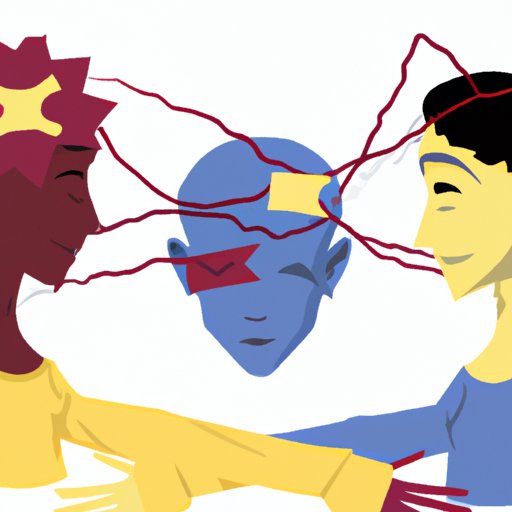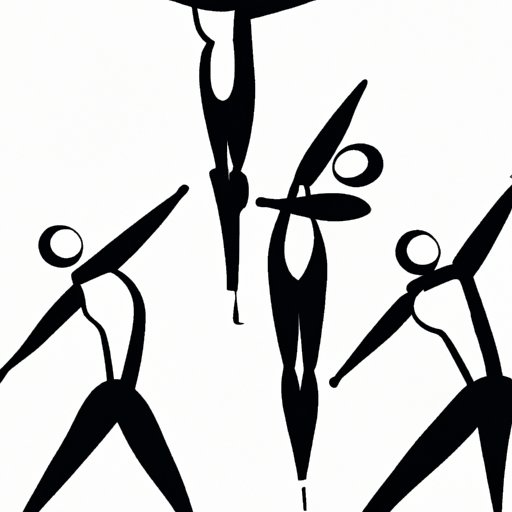Introduction
Dancing is a fun and enjoyable activity that many people enjoy. But for some, the act of dancing can be difficult or even impossible. To understand why some people can’t dance, we need to look at the physical, neurological, psychological, cultural, emotional and social factors that can contribute to difficulty in dancing.

Analyzing the Physical Challenges that Prevent Dancing
When it comes to physical challenges that make dancing difficult, there are several factors that can come into play. Poor coordination, balance problems, strength and flexibility issues are all common reasons why some people have trouble with dancing. Let’s take a closer look at each one.
Poor Coordination
Poor coordination can be caused by a number of physical conditions, such as muscular dystrophy or cerebral palsy. It can also be due to a lack of practice and experience in moving the body in a coordinated fashion. In either case, poor coordination can make it difficult for individuals to keep up with the steps and rhythm of a dance.
Balance Problems
Balance problems can also interfere with an individual’s ability to dance. Balance issues can stem from inner ear disorders, vertigo, vision problems, or other physical conditions. Without proper balance, it can be difficult to maintain the proper posture and alignment needed for dancing.
Strength and Flexibility Issues
Having weak muscle strength or limited flexibility can also make dancing difficult. If an individual does not have enough strength in their muscles to move their body in the ways required by a particular dance, they may not be able to keep up with the movements. Similarly, if someone has limited range of motion or flexibility, they may not be able to perform certain dance moves.
Examining Neurological Conditions that Affect Movement
Neurological conditions can also interfere with an individual’s ability to dance. Common neurological conditions that impact movement include Parkinson’s Disease, Cerebral Palsy and Multiple Sclerosis. Let’s take a closer look at how each of these can affect an individual’s ability to dance.
Parkinson’s Disease
Parkinson’s Disease is a degenerative condition that affects the central nervous system and can cause tremors and stiffness in the body. These symptoms can interfere with an individual’s ability to move their body in the ways required for dancing.
Cerebral Palsy
Cerebral Palsy is a condition that affects the brain and can cause a disruption in messages sent between the brain and the muscles. This can result in impaired movement and coordination, making it difficult to keep up with the movements required for dancing.
Multiple Sclerosis
Multiple Sclerosis is an autoimmune disorder that can cause a wide range of physical symptoms, including fatigue, spasticity, weakness and numbness. All of these can interfere with an individual’s ability to move their body in the ways required for dancing.
Investigating the Psychological Barriers to Dancing
In addition to physical and neurological factors, there are also psychological barriers that can make dancing difficult for some people. Fear of embarrassment, low confidence levels, and anxiety and stress can all contribute to an individual’s difficulty in dancing.
Fear of Embarrassment
For some people, the fear of embarrassing themselves in front of others can be a major barrier to enjoying dancing. This fear can be so strong that it prevents them from even attempting to dance.
Low Confidence Levels
Individuals who lack confidence in their ability to dance may be hesitant to try. They may worry about looking foolish or being judged by others, leading them to avoid dancing altogether.
Anxiety and Stress
Anxiety and stress can also interfere with an individual’s ability to dance. When someone is feeling anxious or stressed, their mind is preoccupied and they may not be able to focus on the steps and movements required for dancing.
Looking at Cultural Factors that Inhibit Dance Participation
Cultural factors can also play a role in preventing some people from dancing. Religious prohibitions, lack of cultural understanding, and gender roles can all contribute to difficulty in dancing.
Religious Prohibitions
Some religions prohibit dancing, which can make it difficult for individuals of those faiths to participate in dance activities. This can be especially true in more conservative cultures where religious beliefs are strictly adhered to.
Lack of Cultural Understanding
In some cases, an individual may not feel comfortable participating in a type of dance that is unfamiliar to them. If someone does not understand the cultural context of a particular dance, they may feel uncomfortable trying it.
Gender Roles
Gender roles can also play a role in inhibiting dance participation. In some cultures, men are discouraged from dancing while women are encouraged to do so. This can create a barrier for men who wish to learn or participate in a particular style of dance.

Exploring Emotional Difficulties That Disrupt Coordination
Emotional difficulties can also interfere with an individual’s ability to dance. Depression, grief, and trauma can all lead to difficulty in coordinating the body’s movements in the ways required for dancing.
Depression
Depression can cause feelings of hopelessness and worthlessness, which can interfere with an individual’s ability to stay focused on learning and performing dance steps. Additionally, depression can cause physical symptoms such as fatigue, which can further impede an individual’s ability to dance.
Grief
Grief can also interfere with an individual’s ability to dance. Grieving individuals may not have the energy or motivation to learn and practice dance steps, or they may find it difficult to concentrate on the task at hand.
Trauma
Trauma can also disrupt an individual’s ability to coordinate their body’s movements. Traumatic experiences can cause an individual to become hyper-vigilant and over-sensitive to their environment, making it difficult to focus on learning and performing dance steps.

Discussing Social Stigmas That Discourage Dancing
Social stigmas can also discourage some people from dancing. Judgement from peers, negative body image, and lack of support can all contribute to an individual’s reluctance to participate in dance activities.
Judgement from Peers
The fear of being judged or ridiculed by others can be a major deterrent to dancing. Individuals may worry that they will be seen as clumsy or awkward, leading them to avoid dance activities altogether.
Negative Body Image
Negative body image can also make it difficult for some people to enjoy dancing. Individuals who feel self-conscious about their bodies may find it hard to relax and move freely when dancing, leading them to shy away from the activity.
Lack of Support
Finally, a lack of support from family and friends can also be a barrier to dancing. If an individual feels that they have no one to turn to for help or encouragement, they may be reluctant to pursue dance activities.
Conclusion
As we can see, there are a variety of physical, neurological, psychological, cultural, emotional and social factors that can prevent some people from dancing. It’s important to remember that everyone is different and that what works for one person may not work for another. If you or someone you know is having difficulty with dancing, there are resources available to help. Seek out professionals, such as physical therapists, neurologists, psychologists, or dance instructors, who can provide guidance and assistance.
(Note: Is this article not meeting your expectations? Do you have knowledge or insights to share? Unlock new opportunities and expand your reach by joining our authors team. Click Registration to join us and share your expertise with our readers.)
